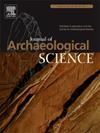Solidification simulation of the Anyang niuzun: Insights into late Shang Dynasty bronze casting techniques
IF 2.5
1区 地球科学
Q1 ANTHROPOLOGY
引用次数: 0
Abstract
Ritual vessels of the Bronze Age in China, are numerous and their exquisite craftsmanship offers a means to understand ancient Chinese society. Important bronzes have been unearthed at the site of Yin, the late Shang dynasty capital city, in present-day Anyang. One particularly significant example discovered in the Yin ruins is a cattle-shaped wine vessel (niuzun). This study combines archaeological observations and solidification simulation methodology to investigate the casting technologies used to produce this vessel and to evaluate bronze craftsmanship at the Yin capital city during the Late Shang Dynasty. By reconstituting the process of the vessel's dynamic solidification, it was found that the niuzun's features have an even wall thickness design, use metal chaplets, and incorporate bronze patches. In addition, the artisan's deliberate sprue placement significantly reduced casting defects. These findings indicate that by the late Shang Dynasty, artisans had already mastered piece-mould casting techniques, and that for the exquisite bronze niuzun, they designed an impeccable mould conforming to extremely high casting standards. This study provides a novel perspective on understanding ancient metalwork technology considering transient solidification processes, and offers valuable insights for studying other metal relics.
安阳牛尊的凝固模拟:商代晚期青铜铸造技术的启示
中国青铜器时代的礼器数量众多,其精湛的工艺为了解古代中国社会提供了一种手段。殷城,商朝晚期的都城,在今天的安阳,出土了重要的青铜器。在殷墟中发现的一个特别重要的例子是一个牛形的酒器(牛尊)。本研究结合了考古观察和凝固模拟方法,研究了用于生产该容器的铸造技术,并评估了商代晚期殷墟的青铜工艺。通过重构容器的动态凝固过程,发现牛尊的特征具有均匀的壁厚设计,使用金属链,并结合青铜补丁。此外,工匠精心设计的浇口位置显著减少了铸造缺陷。这些发现表明,到商代晚期,工匠们已经掌握了单模铸造技术,对于精美的青铜牛尊,他们设计了一个完美的模具,符合极高的铸造标准。该研究为认识瞬态凝固过程的古代金属加工技术提供了新的视角,并为研究其他金属文物提供了有价值的见解。
本文章由计算机程序翻译,如有差异,请以英文原文为准。
求助全文
约1分钟内获得全文
求助全文
来源期刊

Journal of Archaeological Science
地学-地球科学综合
CiteScore
6.10
自引率
7.10%
发文量
112
审稿时长
49 days
期刊介绍:
The Journal of Archaeological Science is aimed at archaeologists and scientists with particular interests in advancing the development and application of scientific techniques and methodologies to all areas of archaeology. This established monthly journal publishes focus articles, original research papers and major review articles, of wide archaeological significance. The journal provides an international forum for archaeologists and scientists from widely different scientific backgrounds who share a common interest in developing and applying scientific methods to inform major debates through improving the quality and reliability of scientific information derived from archaeological research.
 求助内容:
求助内容: 应助结果提醒方式:
应助结果提醒方式:


